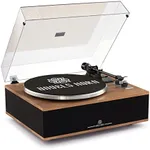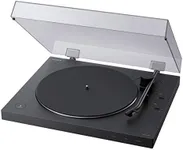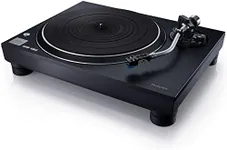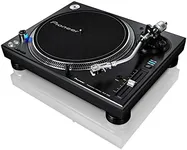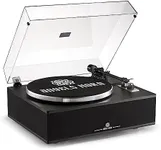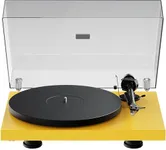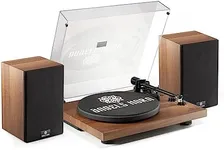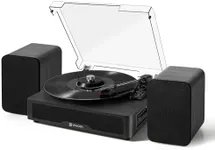Buying Guide for the Best Vinyl Record Players
Choosing a vinyl record player is an exciting journey, especially as it combines both nostalgia and the love for music in its purest form. A record player not only plays your favorite albums but can also be a beautiful addition to your living space. When searching for the right one, it helps to understand the main features and specifications so you can find the perfect fit for your listening style and space. Focus on your personal needs, like where you'll use it, what kind of music experience you want, and your plans for growing your vinyl collection.Drive TypeThe drive type refers to the mechanism that spins the turntable platter. There are two main types: belt-drive and direct-drive. Belt-drive turntables use an elastic belt to spin the platter, which can help isolate motor noise and give you a purer sound, making them popular with those interested mainly in home listening. Direct-drive turntables have the motor directly under the platter, offering stronger torque and faster start-up—these are favored by DJs and people who may want to scratch or manipulate records. For home listening, belt-drive is often preferred for sound quality, while direct-drive suits those interested in performance and reliability.
Manual vs. Automatic OperationThis specification describes how much you need to do to start and stop playback. Manual players require you to lift and lower the tonearm yourself, which means a more hands-on experience and often appeals to purists who like the tactile part of vinyl. Automatic players handle the movement for you, making them easier and more convenient for beginners or those who want a fuss-free listening session. Semi-automatic models do part of the work, typically lifting off at the end. If you value simplicity, look for automatics; if you enjoy involvement, manual models may be more satisfying.
Built-In PreampA preamp boosts the record player's weak audio signal to a level that other audio equipment can use. Some turntables come with a built-in preamp, making them easy to connect to speakers or amplifiers without special equipment. Others require an external preamp, which can provide higher sound quality but adds an extra step and cost. If you don’t have an audio system with a phono input, look for a player with a built-in preamp for an easy setup. For those who want to invest in high-end sound over time, an external preamp may be the best route.
Cartridge and Stylus QualityThe cartridge and stylus (needle) are key to reading the grooves on your records and converting them into sound. Entry-level players may have basic cartridges, which are fine for casual listening. Higher quality cartridges and styluses track grooves better and last longer, giving richer detail and less record wear. Some players allow for easy upgrades; if you want to customize or improve sound later, look for models with replaceable cartridges and styluses. For casual use, factory-fitted options are usually sufficient.
Speakers and ConnectivitySome modern record players come with built-in speakers, while others need to be connected to external speakers or stereo systems. Built-in speakers are convenient if you have limited space or want a simple setup, but they often don’t sound as good as dedicated speakers. Record players with outputs—such as RCA, Bluetooth, or USB—allow for better audio quality and more flexibility, especially if you already own speakers or want to digitize your vinyl collection. Think about where and how you’ll listen: for portability and ease, built-ins work; for serious listening, look for external connectivity.
Build Quality and MaterialsThe materials used in the turntable frame, platter, and tonearm affect both the sound and durability of the player. Heavier, well-damped materials help reduce vibrations that can cause unwanted noise. Plastics are common in entry-level players and keep things lightweight and affordable, but may introduce more vibration. Metals and hardwoods are used in higher-end models, providing better stability and longevity. If you're seeking the best audio quality, heavier and sturdier construction is worth considering, while lightweight builds are easier to move and set up.
